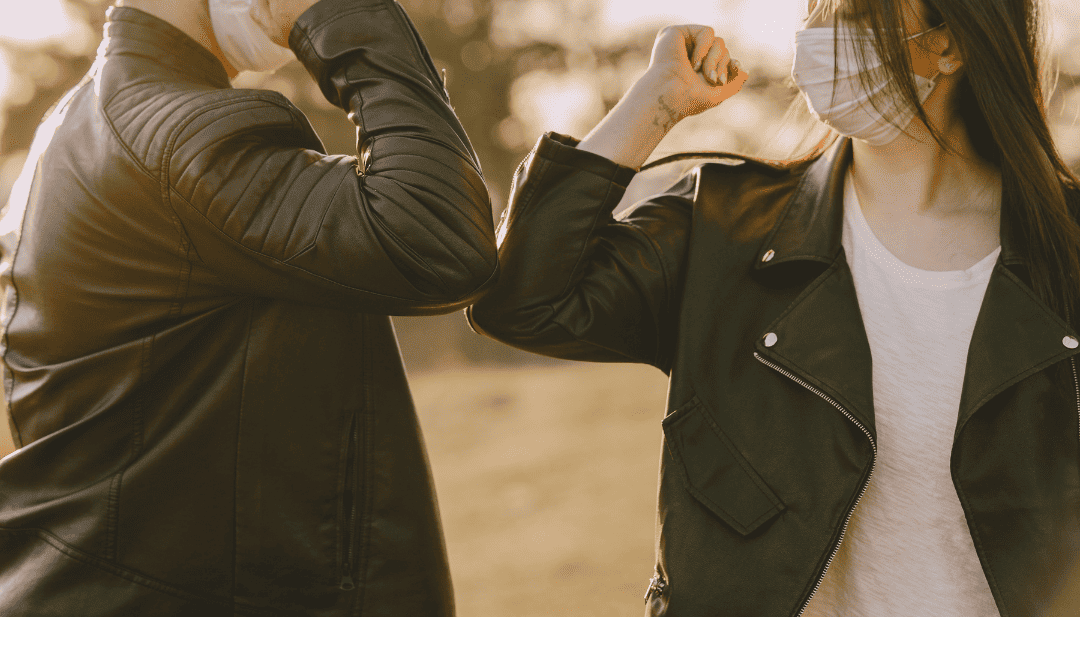Covid 19 has affected all areas of our lives, including etiquette. Etiquette is defined as “the customary code of polite behavior in society, or among members of a particular group”. In other words it’s how we conduct ourselves with others, and how we treat those who we know well (or don’t know at all). Etiquette is always evolving, and has certainly seen some big changes in the past year.
No More Handshakes
Not too long ago, I was teaching and demonstrating the correct way to shake hands during my sessions to college students on business etiquette. Now, due to fears of spreading the virus, we are no longer shaking hands, and have moved to the elbow or fist bump. This is not a bad thing, however if you’re not sure what to expect can lead to some awkwardness at the end of a meeting. For an elbow bump to succeed it’s best if you’re standing opposite your intended, and both use right arms to bump. I suggest being prepared for any scenario, however, so if a fist or elbow bump doesn’t happen, a third option is a nod, with slight smile.
Inquiring About Health
It has always been polite to ask others how they are, and in past years the polite response was “fine”. That way the conversation could turn easily to other topics. During the pandemic, however, inquiring after others’ health, and that of their loved ones, has taken on a new significance. You cannot always assume the response will be “fine”. So, current etiquette asks you to spend a little more conversational time on health and wellness, and to truly listen to others on this topic. Keep in mind their response so you can follow up on it, if appropriate. And please, do offer gratitude if the answer remains “fine”.
Wearing a Mask
A mask has become an essential item when going out, along with keys, phone and wallet. Although we don’t need to wear them everywhere anymore, it’s still polite to don a mask if others are wearing one. And if you have been vaccinated, others do not necessarily know that, so wearing a mask in public is still the polite and etiquette friendly thing to do.
Keep in mind, you can create a mask wardrobe, and treat your face masks like shoes, earrings or any other accessory. Have several on hand, and choose the one that matches your outfit, or your mood. If you’d like to read more on this, I was quoted on this topic in USA Today. Read Article. If mask fashion doesn’t interest you, then simply stick with solid black, white, or tan.
More Attention to Non-Verbal
With masks hiding the lower half of our faces as we’re out and about, it becomes even more important to read others’ non-verbal cues. We can no longer see if there is a smile, a frown, or teeth set in the manner of “it’s okay but I’m not happy about it”. We can, however, get this information from body language cues, such as arm/hand movements, posture and eye signals. Keep in mind: when someone’s palms are facing you, they’re receptive to information and open to new ideas. Palms away from you, is the opposite. Eyes gazing at you means someone wants to engage in conversation and/or senses a potential connection. Lastly good posture signals confidence, health and optimism.
We are also seeing a lot less randomly touching others. This has never been a good idea etiquette-wise, however many have gotten away with it. For comfortable conversation, we all require a certain amount of distance between us. So, where that close friend, or not so close friend, or almost stranger stands makes a difference. Pre-pandemic, the distance was 18 – 24 inches. It’s far enough to still read other’s body language, but not too close for comfort. Social distancing guidelines, of course, recommend a distance of more than double that, 4 – 6 feet. Which makes standing too close a thing of the past. Randomly touching others is out, and considered boorish and unhealthy.
Consider these tips, and plan your own body language accordingly. This way you can learn to hear what others are communicating, behind their mask.


